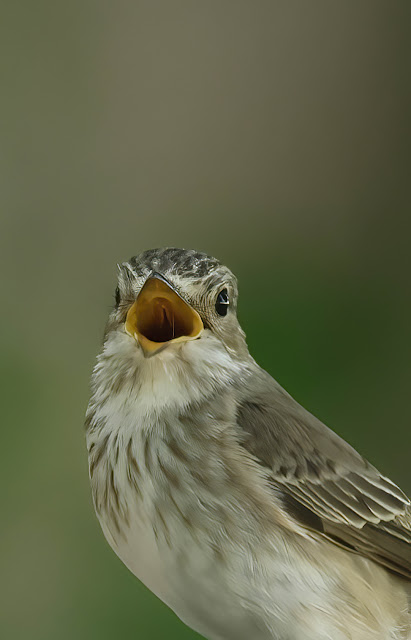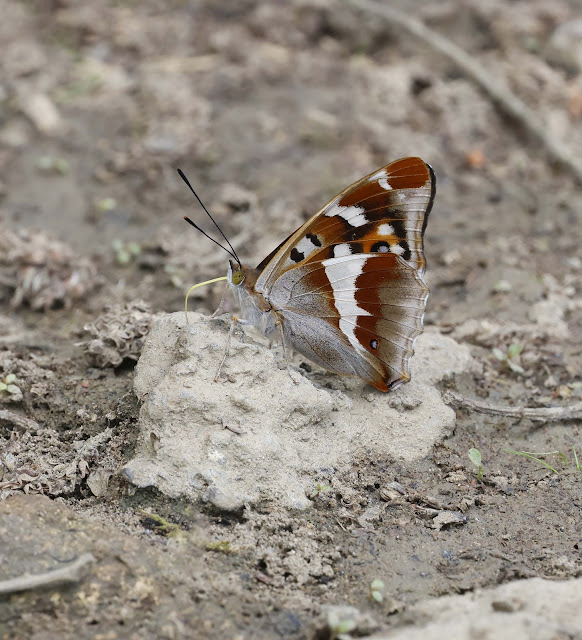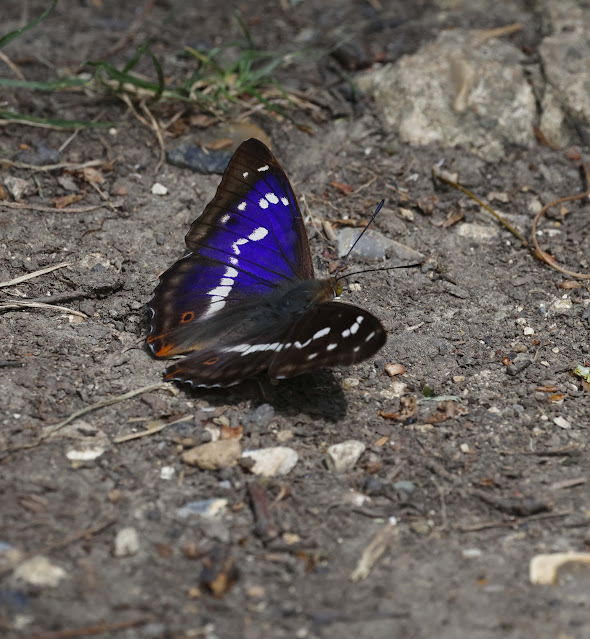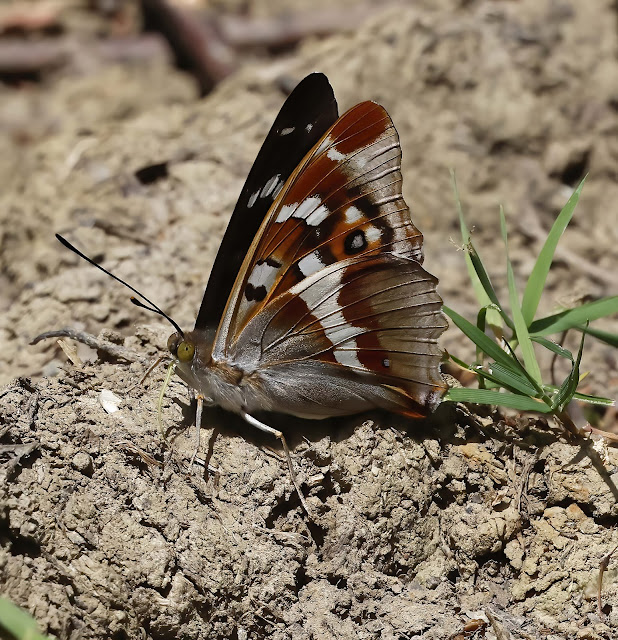Saturday, 28 June 2025
Spotting Flycatchers 27th June 2025
Saturday, 21 June 2025
Trials and Tribulations with His Excellency 20th June 2025
I returned to the same ride where I had success two days ago full of optimism but I should have known better. It is rarely that easy. Never is it the same from one day to the next. This time the weather, although warm and humid was for the first part of the morning lacking in sun. Whether this contributed to the distinct absence of an Emperor I could not say although probably it did but then they are so capricious and cantankerous it could be for a host of other reasons. Such are the trials and tribulations of finding an Emperor but that is also the incentive, the challenge of seeking him out, for when success finally comes your way (and it often does not) it is all the sweeter.
I lingered along the ride for two hours but there was not even an intimation of His Majesty being present.I regularly scanned the tops of the oaks where Emperors spend most of their life but there was no sign of one flying up there either. Other enthusiasts came and went and we exchanged commiserations and general chat. During one of these conversations I learned that an Emperor had been seen in the forest's main car park earlier. There is always the temptation to abandon one's current spot and hurry to where one has been reported but it's pointless as the butterfly will usually be long gone and anyway I was rather partial to this ride and its quiet, rural ambience, so different to the constant coming and going of cars, people and dogs in the main car park and the well used track leading from it.
By mid morning the sun had begun to assert itself through the thin veil of cloud and my hopes rose.Would the Purple Enigma put in an appearance now?.The answer was no, however a male Silver washed Fritillary deigned to cease its customary madcap charging through the trees and settled to nectar on a bramble. Obviously fresh he flexed his orange wings as he fed but then was off again on his ceaseless mission to find a mate
 |
| Silver washed Fritillary |
Two and half hours passed with nothing to show for my vigil. A fellow enthusiast came up the ride, heading back to the car park and enquired if I had seen a White Admiral. I told him no and suggested he try the cross roads at the main track.He went on his way and a minute later a White Admiral glided through the trees but did not stop. That's butterflying for you.
I too decided to make a move and opted to follow the same route and walk to the main car park and then return to the ride to make my way back to my car, parked at the far end of the meadows.
Any thoughts of seeing and photographing an Emperor on the ground were long since abandoned. Just to see one, if only in passing was now what I was reduced to. Anything!
Walking along the narrow track which runs between my favoured ride and the main track I saw the person who had passed me earlier pointing a camera at the ground. I was not particularly concerned, for as far as I knew Emperors have never been seen here as the surrounding trees are mainly birch with perhaps the occasional oak. I was wrong of course. As I approached closer he turned towards me and pointed at the unmistakeable profile of an Emperor that was flying down the track towards me at speed. There was just time for my brain to catch up with reality and my eyes to register a flash of purple and white before he powered past and flew further down the track, where I lost sight of him.
Well my wish had been granted.I had seen an Emperor, if only in a brief flight view and that after almost three hours. I retraced my steps along the track in the hope it may have landed further on but predictably there was to be no happy ending. So close.So very frustrating.
I returned to the end of the track where it joined the main track and encountered my friend again.Standing by some trees and bushes and again pointing his camera at something.
Is this another Emperor? he enquired
He pointed to a leaf on a low branch on which sat a large brown butterly with two prominent white bands across its spread wings.
For a moment but only a moment my heart gave a leap before it became obvious it was a White Admiral, newly emerged and in absolutely pristine condition. Under normal circumstances I would be really pleased with such an encounter but it was nullified by my overwhelming desire to see an Emperor,. especially having come so close just minutes ago. Second best simply would not do!
Nonetheless we took the opportunity to take some photos of the butterfly and very nice it was too, posing perfectly before glding away in its inimitable, buoyant and graceful manner through the trees.
Chatting to my erstwhile friend he told me he was from Manchester and had come down especially for the day, was new to butterflying and his desire was to see a Purple Emperor and a White Admiral, both of which would be new for him and in the space of a few minutes he had achieved his ambition! I smiled graciously and congratulated him whilst inwardly wanting to groan in frustration.
He told me the Emperor had been feeding on the path and he showed me his photos.It was sheer luck but that is often the way here. You have to be in the right place at the right time and there is no way to legislate for such things and Bernwood Forest is a big place.
 |
| White Admiral |
 |
| To the right |
 |
| To the left |
 |
| Hurrah! |
Thursday, 19 June 2025
His Imperial Majesty 18th June 2025
In the end I decided on Bernwood Forest.The woods and meadows are a joy to be in at this time of year as we approach the summer solstice and there was always the off chance of an early Purple Emperor putting in an appearance, although I was not particularly concerned if I encountered one or not.That was not the prime purpose of my excursion to Bernwood today. I just felt the urge to be out in the natural world and at a time of year when rural Oxfordshire is looking at its best.
Rather than making for the popular and often overcrowded main car park at Bernwood I sought the small and easily overlooked car park at the other end of the woods that marks the entrance to Bernwood Meadows Nature Reserve, two traditional hay meadows that somehow have remained unimproved over the years and are now in the care of BBOWT (Berks Bucks and Oxon Wildlife Trust) who continue to manage them sympathetically and as a consequence they are a haven for wild flowers and insect life. As I hoped the tiny car park was devoid of any other cars and I was on my own, all set to wander at will in a plethora of flora and attendant insects.
Yellow and white were the predominant colours transforming the meadows into an impressionist like canvas, by means of white oxe eye daisies and yellow cats-ears, each plant a dab of bright colour spreading across the meadows in infinite number amongst the summer grasses being gently stirred by a benign summer breeze. Towards the blackthorn hedges that mark the boundaries of the two meadows the ragged purple heads of greater knapweed formed patches of alternative colour.
.jpg) |
| One of the Bernwood Meadows |
A pleasant surprise came shortly after entering the meadows as I disturbed a large butterfly in my passing which looped in a circle around me and returned to the knapweed head it had been nectaring on. It was a Painted Lady, somewhat frayed at the edges and looking decidedly worn but still attractively patterned in orange, black and white. They cannot survive the winter here so uniquely amongst our butterfly species they migrate south to winter in the warmth of north Africa before returning in the Spring. This, judging by its 'tired' appearance was the history of this individual, a returning migrant its remaining days surely numbered but for now content to bask and feed in the sun.
 |
| Painted Lady |
Male Marbled Whites were everywhere, it was impossible to ignore them fussing about, almost at ground level, their wings flickering black and white as they passed through and over the grass and flowers, constantly searching for females, doubling back and fore in case they had missed a female lurking in the grass. Judging by their endless activity most were unsuccessful but one or two, with persistence would surely get lucky.
 |
| Marbled White |
In direct contrast to the boldly coloured and obvious Marbled Whites, another butterfly, the Small Heath, was the epitomy of pale brown insignificance and easily overlooked, the tiny insects hugging the similarly coloured sun parched ground as they flew at my feet.The inevitable Meadow Browns and Ringlets flounced and flopped amongst the grasses too or made brief aerial excursions to examine the higher reaches of the blackthorn hedges..It was impossible not to be energised by this abundance of natural life all around me.
At the furthest end of the meadow I passed through the metal gate that grants access to the forest, still not having seen anyone and walked a familiar rutted ride, the clay dried to the hardness of iron by the sun and lack of rain.This is part of Forestry England's 'butterfly trail' through the wood and that eventually leads from the meadows to the main car park some way distant.
.jpg) |
| The Emperor's domain |
I have encountered Purple Emperors here many times, the combination of oak and sallow that border the ride ideal for His Imperial Majesty (HIM) and His Empress but not today it seemed. An occasional Silver Washed Fritillary powered past. The size of an Emperor, a hyperactive ginger biscuit coloured butterfly, they hurtle along the ride forever searching, driven by genetic programming to find a female with which to mate.
I had reached almost to the far end of the ride, when without warning there he was. A shock that caused an involuntary yelp of surprise and joy.
A flash of regal purple.
Could it really be?
Yes it most certainly and wonderfully was!
The butterfly had descended from an oak, uncaring, almost dismissive of my presence, to land right in front of me and commenced probing the ground with his pale yellow proboscis feeling for the minerals and salts he desired.
A male Purple Emperor, in absolutely pristine condition and probably newly hatched, possibly this very morning.
Although it is sheer speculation on my part I wondered if he was so recently emerged he required to charge his energy reserves as rapidly as possible by visiting the ground to imbibe minerals for the remaining short but highly active period of his adult life.
He wandered around probing the hard ground, the sun catching one wing and causing it to blink regal purple but he was dissatisfied with what he found and was gone, back up into the oaks. I managed to catch one more magnificent flash of purple as he angled his wings in the sunlight before departing. A lucky shot but that is often the way it goes. Be grateful as this is a butterfly that spends most of its life high in the trees and only occasionally descends to feed on the ground, behaviour contributing in no little part to its allure and enigmatic reputation.
For twenty minutes I lingered at this spot but then in customary contrary fashion he descended further down the ride and again commenced probing the ground, seeking the sustenance that had so far eluded him but again he was not content and flew at head height back up the ride towards me, cruising in long powerful glides with an occasional casual flick of his wings to maintain speed, granting a tantalising flash of purple on sun kissed wings before I lost sight of him and it was obvious he was gone.again.
There was to be one more visit. A third and final time he settled on the ride, this time with wings closed and giving me just time enough to record the equally impressive, complex patterning of his underwings.
Still not happy he was off once more, cruising up and down the ride searching in vain but then veering off to ascend up into the surrounding oak trees and this time I knew he was gone for good.
Always it is never enough with these encounters. An audience with this most charismatic and legendary of British butterflies is for me the ultimate experience possible from our impoverished list of native butterflies and so much desired that any encounter inevitably leaves me reluctant to depart and forever wanting more.
Capricous, irritating, frustrating, unpredictable, eccentric are all adjectives that can be applied to this most majestic of insects but anyone who searches for His Excellency will tell you they will put up with all this and more for an audience.When it does happen the sense of achievement and triumph is overwhelming.
Bernwood Forest will soon be full of butterfly afficionados as it is a well known site for seeking the Emperor. The coming weekend in particular, predicted to be sunny and hot will see many people hoping for a glimpse of one. Luck plays a huge part plus a little knowledge of their habits and behaviour but perhaps the great charm of seeking out HIM is the sheer unpredictability and random chance of seeing one with the knowledge that when you do find one it feels like something very special has touched you and brought you close to another wonder of our still beautiful world.
I can but quote the words of Matthew Oates, who is a self confessed fanatic when it comes to Purple Emperors and has devoted a lifetime to following and studying the Purple Emperor and probably knows more than anyone else about their lives.
'Welcome to the world of the Purple Emperor, the one the Victorian butterfly collector saluted as His Imperial Majesty (or HIM), the Emperor of the Woods and the Lord of the Forest, to name but three of many salubrious epithets.This is the one butterfly they most wanted to possess, to form the centrepiece of their precious collections.This is the one today's butterfly enthusiasts most want to experience and understand. It is mysterious, elusive, ebullient, enthralling and highly amusing and it transports us into a world that is very different from the one we know - yet is a reality in which we feel wondrously at home'.
His Imperial Majesty A Natural History of the Purple Emperor Matthew Oates 2020
Monday, 16 June 2025
A Desert Wheatear at Keynsham 15th June 2025
The report came through too late for me to consider going to see the wheatear that same day and anyway the bird had subsequently been reported as going to roost in nettles by the wooden boundary fence surrounding the playing fields
I decided that if it was reported as still present the next day I would make the ninety minute drive to Keynsham in the hope of seeing it.
Desert Wheatears are a rare vagrant to Britain although an average of four or five turn up most years and records are thought to be increasing. Up to the end of 2023 one hundred and seventy four have been recorded in Britain.They breed in the desert and arid regions of North Africa from Morocco to the Middle East with further populations extending east as far as Mongolia and northern China. Some North African birds are resident but the majority spend the winter further south in the Sahara and Sahel regions, extending from Mauretania eastwards to Ethiopia and Somalia.
I have seen six Desert Wheatears of both sexes and all ages in Britain, the last almost ten years ago but all have been in autumn or exceptionally, one, a female that was overwintering on a beach in northeast Scotland, so this bird's arrival in mid June, the latest ever Spring record in Britain was truly notable.There has in fact been only one other June record and that was way back on the 2nd of June 1906 when another male was found dead below the Pentland Skerries Lighthouse on Orkney.
Maybe it was the hot and humid night that banished sleep from me at 4am or perhaps it was the familiar Blackbird's languid contralto song from my neighbour's cherry tree that came to me through the open bedroom window but whatever it was I set about the process of joining body and soul into a cohesive whole.
As I lay on my bed wondering about the wheatear and thinking news about it would not be forthcoming for some time, half an hour later I was startled by a ping on my phone alerting me to a message from one of the birding WhatsApp Groups I am a member of, relaying news that at 4.34am this very morning a fellow early riser had found the wheatear was still present on its favourite fence by the playing fields..
There was definitely no chance now of further horizontal contemplation and in fifteeen minutes I was out of the door and driving westward into what promised to be a pleasant and warm day. At such an early hour the rural roads I took were deserted apart from the usual suicidal Wood Pigeons at the roadsides.Why do they wait so long before flying from oncoming cars, causing anxious moments as I become convinced I will collide with one.
My otherwise uneventful journey ended in what looked to be a landscaped development of recently built houses packed into a warren of small closes and cramped cul de sacs that offered very little scope to park. A large car park lay adjacent to the playing fields but I managed to find a parking place in one of the surrounding roads and saved myself a parking fee.
At 6.30am on a Sunday the place was predictably silent as doubtless all the residents were still enjoying a lie in. I soon found the footpath that sloped down from the housing to the extensive area of playing fields on one side of the path and grassland on the other and I could see several birders already standing by the fence line.
Joining them, the wheatear was pointed out to me perched on the metal frame of one of the goals at the edge of the playing fields.This was my first view of the bird but it soon moved to the wooden railing/fence that ran behind the goals and secured the playing fields from the outside world.
The wheatear would utilise the frames of the goals or the wooden railings as elevated perches from which to sally forth to seize prey from the grass of the playing field, often flying quite some distance to seize whatever it had seen. It rarely remained on the grass for more than a few seconds before seeking the comparative safety of the goal frames or wooden railing.
It showed a marked preference for one particular corner of the playing field conveniently near the path and I stationed myself there although it could move quite a long way along the fenceline but I knew to be patient as it always gravitated back to this particular corner.
Other birders followed it to wherever it moved but I have long adopted the principle that it is best to wait for the bird to come to you rather than the other way around and this is what I did with a more than acceptable outcome.
During my time with the wheatear there were never more than twenty or so people present and as usual it was nice to meet up with some familiar faces and pass some time with them.
This individual was a first summer male told by its worn wing and tail feathers, more brown than black and which in an older bird would be fresher and blacker .Otherwise it was a pleasing combination of sandy buff upperparts, paler underparts and a black face, chin and wings.When it flew it exposed a conspicuously large area of white on its rump and an all black/brown tail.
For two hours I watched as the bird alternated between feeding and preening.Judging by its hyperactive feeding behaviour and frequent bouts of feather maintenance I sensed it was keen to depart and would probably leave in the following night.
Update
It was not seen the next day


.jpg)
.jpg)
.jpg)
.jpg)










.jpg)




.jpg)











.jpg)













.jpg)
.jpg)
